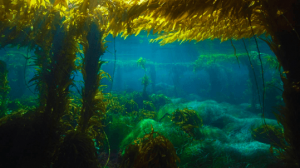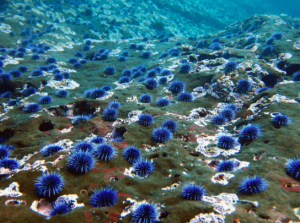Is Kelp A Keystone Species
Keystone Species are those of any organism that are considered crucial to the structure of the ecosystems in which they belong. The bounding main otter is an excellent example of a keystone species for the kelp forest ecosystem off the coast of California. Keystone species are important because they help promote biodiversity by controlling species that would otherwise dominate the biological community in which they reside. Also, these species tin provide essential resources to other species within the community. Many keystone species are predators like a jaguar, but not all, some are herbivores similar the African elephants in the savanna ecosystem.
Without keystone species present, the ecosystems would go dramatically unlike and many other species could be lost.

kids.nationalgeographic.com
The term keystone refers to the middle stone of a span that is wedge shaped and helps hold the others in place. If this stone is removed the entire bridge should collapse in on itself. The same thought goes for an ecosystem that loses a keystone species. Keystone species are and so vital to the communities in which they belong considering they are the stone that maintains the construction and function.

An American zoologist Robert Paine was the first to coin the term keystone species back in 1966. While studying the rocky intertidal ecosystem in the Pacific Northwest, Paine observed dramatic changes to the biological community when the Starfish (Piaster ochraceus) was removed.
Of course, one of the most popular examples of a keystone species is the sea otter (Enhydra lutris) within the kelp wood ecosystem. Every bit a member of the weasel family unit, the sea otter does not posses insulation in the grade of thick blubber as many other marine mammals exercise. Instead the sea otter has an extremely high metabolism and the densest fur of whatsoever creature on the planet! The sea otter has such an appetite; information technology must consume 25 percent of its own torso weight daily! Body of water otters may appear cute and cuddly to humans, simply they are really voracious predators keeping the populations of invertebrates similar sea urchins in check. They provide balance in the kelp wood by controlling the populations of invertebrates that feed upon the kelp.

mountainandsea.org
Unfortunately, Russian fur traders sought later the pelts of the body of water otters along the pacific declension of Due north America throughout the 17 and 1800'south. Somewhen traders diminished the otter populations to the brink of extinction. This decimation wasn't just trouble for the otters, the productive kelp forest ecosystems were greatly affected.
The populations of urchins within the kelp forest ecosystem expanded without sea otters as predator to keep the urchins from overpopulating. Body of water urchins graze on the holdfasts of the kelp, and if gone unregulated, they can wipe out whole forests considering the kelp can no longer ballast itself and but floats abroad. This process can create desolate urchin barrens in areas that were once productive kelp forests. It'south not merely the kelp itself that is impacted; there are over 800 species that rely on the kelp for food and habitat. Once the kelp is gone many species disappear with it, thus providing evidence that the ocean otter is a vital keystone species.

1photo1day.com

Since the protection of sea otters, populations have increased in areas similar Big Sur and Monterey Bay, California, but they still remain an endangered species. People are not sure if sea otter populations will ever fully recover, simply hopefully we tin can learn from this important keystone species for time to come decisions facing ecosystems all over the world.
Written By: Chad Brewer
Is Kelp A Keystone Species,
Source: https://cimi.org/blog/the-keystone-species/
Posted by: mesabour1992.blogspot.com


0 Response to "Is Kelp A Keystone Species"
Post a Comment